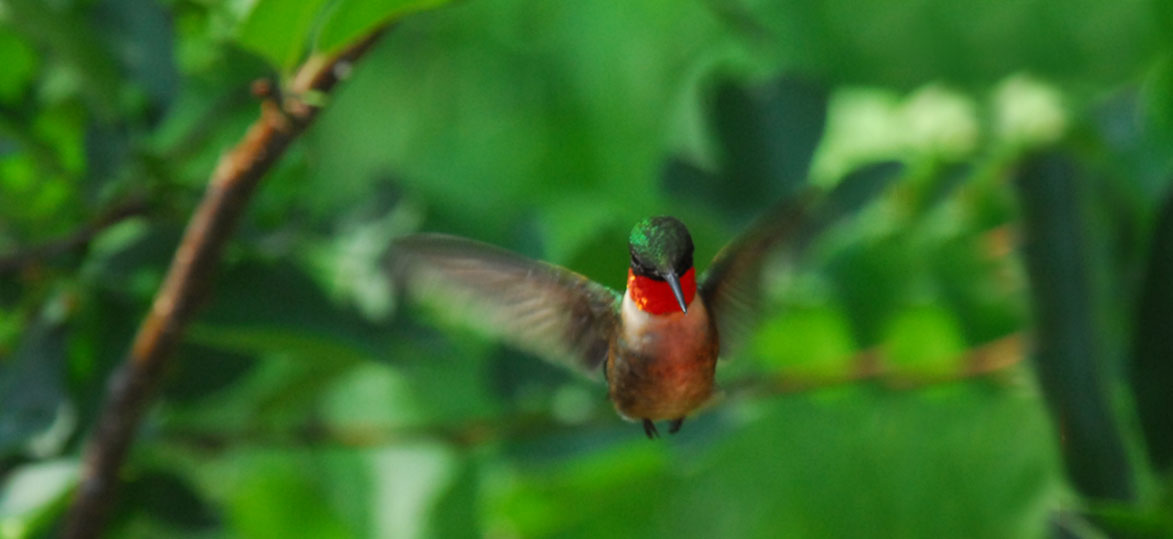
The Ruby-throated Hummingbird (Archilochus colubris) is named after the "humming" sound its wings make as it hovers in the air; the hummingbird is often seen in Vermont during the summer.
Hummingbirds are the smallest of all birds, and the only bird that can fly backwards, as well as hover in one place. It averages 70 wing beats per second.
Habitat
The Ruby-throated Hummingbird returns to Vermont in the beginning of May and is gone by the end of September. In the summer, the Ruby-throated Hummingbird lives in suburban parks and gardens, as well as in woodlands. It will nest in gardens, orchards, roadside thickets, and woodland clearings, and often chooses habitat near or even over running water in open woodlands. In the fall, the Ruby-throated Hummingbird will migrate south, travelling 2,000 miles or more, to reach the wintering grounds in Central America.
The Ruby-throated Hummingbird is not a very social bird and, with the exception of the breeding season, interacts only by voice. The male uses various calls to attract a mate as well as to protect his territory.
Reproduction
After wintering in the southern portion of its range, the male hummingbird returns to the breeding grounds before the female to establish and defend its territory. The breeding season begins in April and continues through July. During courtship, the female sits quietly on a perch while the male flies in a wide, pendulum-shaped arc and buzzes loudly at the bottom of each arc.
The female Ruby-throated Hummingbird then constructs a small nest, about one and a half inches in diameter. She generally builds it in a forest opening or in close proximity to a water source, saddled on the branch of a tree, five to 20 feet off the ground. The nest is built of soft down from ferns, milkweed, fireweed, or thistles, and is held together by spider or tent caterpillar's webs and covered with lichen.
A clutch of two tiny white eggs, about the size of large peas, is then laid and incubated for 11 to 16 days. The female has the sole responsibility for incubating the eggs as well as raising the chicks once hatched as the male plays no role in the rearing of the young. The young hatch and, after approximately 20 days, fledge, or learn to fly. Occasionally, two broods are raised in a summer, but usually only one.
Diet
The Ruby-throated Hummingbird generally does not eat while perched. It hovers in front of a flower, pokes its needle like bill into the center, and sips the nectar inside. This flower nectar is high in sugar, which provides the enormous amount of energy needed to keep up the hummingbird's flight. Because of its high metabolism, this little bird often eats its weight (about three grams) in food every day!
The Ruby-throated Hummingbird will feed on a variety of flowers but is especially attracted to trumpet shaped red flowers such as salvia, bee balm, petunias, jewelweed, and thistles. It will also feed at artificial feeders, red tubes that are made to look like the flowers they visit, that are filled with sugar water. The Ruby-throated Hummingbird also feasts on insects that it finds in the flowers or flying in the air, this provides a great source of protein.
Management
Ruby-throated Hummingbirds are attracted to trumpet-shaped red flowers. Some wild or weedy areas may already have some of the wildflowers that hummingbirds like, such as thistle, with its prickly purple flowers, and jewelweed, with its dangling orange flowers. Jewelweed is also called touch-me-not because its seedpods have an organic spring that explodes on contact and disperses the seeds. They also enjoy other flowers, such as cardinal flowers, with their vibrant red spikes.
Cultivated flowers, especially those that are red and only have one ring of petals around their center, also attract hummingbirds. They will feed on impatiens, bee balm, hollyhocks, weigela, fuchsia, begonias, morning glories and dark purple iris.
Encourage hummingbirds to visit your yard by planting some of these flowers. You can also hang a nectar feeder to attract Ruby-throated Hummingbirds. To make your own nectar, mix four parts water with one part sugar, which is the recommended maximum concentration. You should not use honey because a fungus harmful to hummingbirds may grow.
The color red attracts hummingbirds; so most feeders have some red parts. Commercial hummingbird mix may be colored red, but this is not necessary if you are making your own mixture.
You can buy hummingbird feeders, in all sizes and shapes. Hang your feeder in the shade from a small tree. Coat the wire attaching the feeder to the branch with mineral oil to block access to crawling insects. A bee guard will prevent wasps and bees from draining the nectar.
You should clean and refill your feeder with fresh nectar on a regular basis to prevent bacterial growth in the sugar solution. Refill it every few days and wash it with hot water and vinegar, especially when a black film becomes apparent.
A large nectar feeder might be more of a problem than a small one if it is not refilled frequently. This allows bacteria more time to grow. Along with frequent cleaning and refilling, use boiling water to mix your nectar to further limit the growth of bacteria and fungus. Allow the mixture time to cool before offering it to the hummingbirds. Unused nectar can be stored in a refrigerator for future use.
Status
In Vermont, the Ruby-throated Hummingbird is fairly common in its preferred habitat during the summer months.
